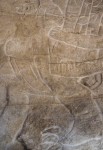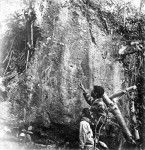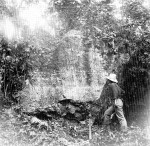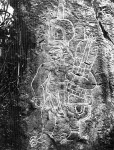 An Olmec relief chiselled off a rock face in the southern Mexican state of Chiapas in the early 70s has surfaced in France and was officially returned to Mexico in a ceremony at the Mexican Embassy in Paris.
An Olmec relief chiselled off a rock face in the southern Mexican state of Chiapas in the early 70s has surfaced in France and was officially returned to Mexico in a ceremony at the Mexican Embassy in Paris.
The relief was discovered at the archaeological site of Xoc and dates to between 1,150 and 900 B.C. It’s 220 centimeters (7’2″) high, 115 cm (3’9″) wide and about 30 cm (one foot) deep. It depicts a man in profile, except for the chest an arms which face front. He has some characteristic Olmec features — thick legs, no neck, small feet, a very high headdress with a crossed band decoration — and some that are very rarely seen in Olmec art, like the round earplug with a curved tassel hanging from it and the sharp talons on his feet. He is clad in breechcloth tied by a large square element. He carries a baton or a knife in his right hand and a bundle in the crook of his right arm that is likely maize.
 It was first discovered in the 1920s, but its remote location and the sparsity of information kept people from exploring it any detail. A few archaeologists saw it, like B. Traven, author of The Treasure of the Sierra Madre which 20 years later would become an iconic Oscar-winning movie by John Houston starring Humphrey Bogart, who photographed it in the 20s. Thirty years later the relief was photographed by Wolfgang Cordan, a German-born poet, fighter in the Dutch resistance against Nazi occupation and anthropologist who roamed the ancient sites of Chiapas in the 1950s and together with William Brito Sansores devised the (now largely discredited) Mérida System of deciphering Maya hieroglyphics. Cordan published the picture in a 1964 book about his Mexican travels, but was deliberately vague on its location.
It was first discovered in the 1920s, but its remote location and the sparsity of information kept people from exploring it any detail. A few archaeologists saw it, like B. Traven, author of The Treasure of the Sierra Madre which 20 years later would become an iconic Oscar-winning movie by John Houston starring Humphrey Bogart, who photographed it in the 20s. Thirty years later the relief was photographed by Wolfgang Cordan, a German-born poet, fighter in the Dutch resistance against Nazi occupation and anthropologist who roamed the ancient sites of Chiapas in the 1950s and together with William Brito Sansores devised the (now largely discredited) Mérida System of deciphering Maya hieroglyphics. Cordan published the picture in a 1964 book about his Mexican travels, but was deliberately vague on its location.
 Because very few traces of an Olmec presence have been found in the hot, humid jungles of the eastern highlands of Chiapas and all of the previous finds were small, portable artifacts, the relief was of great archaeological significance. In 1968 Susanna Ekholm-Miller of the New World Archaeological Foundation undertook to locate the relief in Cordan’s picture. She found a reference in a 1957 survey narrowing down the Xoc site to somewhere between the towns of La Martinica and El Porvenir. She took a puddle jumper to the El Porvenir landing strip and quickly discovered that the locals knew about the site and the relief. An hour-and-a-half horseback ride later, she was standing in front of the rock carving.
Because very few traces of an Olmec presence have been found in the hot, humid jungles of the eastern highlands of Chiapas and all of the previous finds were small, portable artifacts, the relief was of great archaeological significance. In 1968 Susanna Ekholm-Miller of the New World Archaeological Foundation undertook to locate the relief in Cordan’s picture. She found a reference in a 1957 survey narrowing down the Xoc site to somewhere between the towns of La Martinica and El Porvenir. She took a puddle jumper to the El Porvenir landing strip and quickly discovered that the locals knew about the site and the relief. An hour-and-a-half horseback ride later, she was standing in front of the rock carving.
Ekholm-Miller’s expedition was a brief one. Her field director approved a two-day trip, so she had less than two days to clean, photograph and map the site before flying back out. In July of 1972, she got approval for a second, longer trip with a larger team. The elements conspired to make it a much harder and longer slog this time giving them only a day and a half to work on the site. When they arrived, they found to their horror that the relief had been looted.
 From her 1973 paper on the find, The Olmec Rock Carving at Xoc, Chiapas, Mexico:
From her 1973 paper on the find, The Olmec Rock Carving at Xoc, Chiapas, Mexico:
[I]t is impossible to describe the shock and anger we felt when we approached the nearby rock face where previously Eduardo Martinez and I had viewed the magnificent Olmec figure. The carving was no longer there. It had been brutally and completely removed. Apparently it was chiselled off the rock face, probably piece by piece. At least a 30 cm-thick layer of the surface had been removed; a huge pile of fragments of the stone lay at its base, though we could find none that bore any definite carving. We assume that the carved surface is on its way to the antiquities market, undoubtedly in many pieces, as the rock had fissures in it besides being of a limestone which fractures easily.
 In the hope that the unique and priceless artifact might someday be found again, Ekholm-Miller published all her photographs of the relief. They were used to make copies for scholars to study. Though her paper was widely disseminated and the lost relief was very famous among pre-Columbian experts, neither hide nor hair of it was seen or even heard of in the past 45 years.
In the hope that the unique and priceless artifact might someday be found again, Ekholm-Miller published all her photographs of the relief. They were used to make copies for scholars to study. Though her paper was widely disseminated and the lost relief was very famous among pre-Columbian experts, neither hide nor hair of it was seen or even heard of in the past 45 years.
Now that the relief has been recovered, we know that it was cut into four pieces for transportation. When it arrived in France is unknown, but it was soon after the theft. The previous “owners” inherited it and had no idea what it was or where it came from. They contacted pre-Columbian art expert Jacques Blazy and Drouot auctioneer Jean-Claude Binoche to have it appraised. Even stashed in a dark basement, cut into four pieces and filthy, the relief was immediately recognized by the experts, thanks to Ekholm-Miller’s work. They told the family that the piece could not be legally sold.
Blazy and Binoche took the relief to a conservator to have it cleaned and then had it authenticated by preeminent archaeologist Dominique Michelet. One the authenticity of the piece was confirmed, they contacted the Mexican Embassy and arranged for the formal repatriation ceremony.